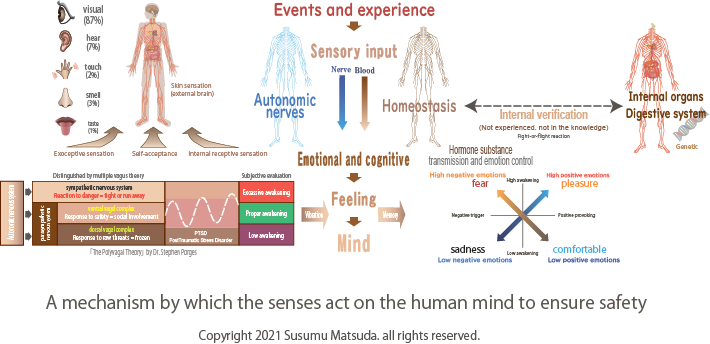Think about human safety rather than the biological mechanism of humans. First, think along the process of a person experiencing an event. This time, I will focus on mental safety, so I will think through the negative experience that has an influence as a mental disorder. Negative sensations are sensations of fear and sadness. It also includes unpleasant and unpleasant sensations. Here, the direction of unpleasant sensations is different, so I will exclude them once. Consider an index that subjectively evaluates a person’s emotions rather than psychologically. The subjective assessment of psychological emotions uses evoked (happy, scary), alertness (excitement, relaxation), and dominance (important, unimportant) according to the Self-Assessment Manikin assessment. We will focus on “fear”, which is highly aroused and contains negative inducing factors, which is reproduced by experiencing a disaster.

Next, think objectively about human emotions. When a person experiences an event, he or she is stimulated by systemic sensations such as five sensations (external receptiveness), equilibrium sensation (self-acceptance), and visceral sensation (internal receptiveness). When stimulated, a homeostatic reaction occurs in the body and at the same time information is transmitted to the autonomic nervous system. The homeostatic reaction is a beast-like reaction that automatically collates the body and instantly determines whether it is in a dangerous state. Stimulation signals are transmitted to various parts of the body through the nervous system and blood vessels. Two paths, one that is transmitted by hormones generated by the stimulus during bodily sensation and the other that is transmitted through nerves by electrical signals, work at the same time. Electrical transmission is transmitted by the sympathetic nerves and parasympathetic nerves of the autonomic nervous system, and the wakefulness is determined. Here, we think that emotions are evaluated according to Dr. Stephen Porges’s Polyvagal Theory multiple vagus nerve theory. I think that the feelings of fear will be transmitted multiple times, and then the heart will be felt after a few seconds. The important point is that the constant reaction that you experience is instantly judged, but it takes 2 to 20 seconds before you can feel the heart. Cases of wrinkles and scary feelings afterwards are thought to represent a state in which hormones are carried by the bloodstream and emotions are slowly transmitted. It is becoming clear that the sensations that influence human emotions are mainly the sensations felt by the body, including the sense of touch. We believe that the degree of fear changes depending on the combination of each sensation and the increase or decrease in the amount of stimulation. In order to protect the human mind, it is also an important theme of safety to properly adjust the amount of stimulation given and to ensure the safety of the mind. We want to elucidate these mechanisms. In thinking about human safety in this way, we are paying attention to Polyvagal Theory multiple vagus nerve theory. In considering the safety of the earth, we are paying attention to Schrodinger theory and string theory.